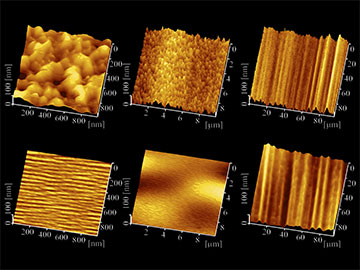Surface roughness before (top) and after (bottom) 150 hours of annealing at different length scales (left to right). The surface roughness, measured by atomic force microscopy, is significantly reduced after the annealing process. [Enlarge image]
X-ray telescopes are crucial for the study of astronomical objects, providing valuable information from a key high-energy part of the spectrum. But as cosmic X-rays are largely absorbed by Earth’s atmosphere, such telescopes must be launched into orbit to do their work. This makes weight a limiting factor and a major expense when putting X-ray scopes on satellites.
Now, researchers from Japan have used micro-electromechanical system (MEMS) technology to create X-ray telescopes that are significantly lighter—and therefore more cost effective—than existing telescopes, without sacrificing resolution (Opt. Express, doi: 10.1364/OE.459774).
A good angle
Angular resolution—the smallest angle between two light sources at which a telescope can still resolve them as separate objects—dictates image quality and thus is key to a telescope’s performance. That can cause problems for space-based telescopes, since increasing a telescope’s angular resolution usually requires increasing the thickness of its mirrors to create an accurate shape. And with greater mirror thickness comes greater weight.
The researchers behind the recent study, led by Yuichiro Ezoe and Aoto Fukushima of Tokyo Metropolitan University, Japan, used the common X-ray telescope configuration, Wolter type 1—which combines coaxial and confocal hyperboloid and paraboloid mirrors—as a starting point. But they solved the weight-versus-resolution problem with a unique refining process.
The researchers began by using a technique developed for MEMS, deep reactive-ion etching, to scoop out 20-µm-wide grooves, or micropores, in a silicon wafer, with the pore sidewalls intended to act as X-ray reflection mirrors. But the team found that the surface roughness of the sidewalls in the etched patterns was too high to allow total X-ray reflection. To achieve high angular resolution, the sidewalls need to be smooth and flat.
Smoothing rough edges
To that end, the team employed hydrogen annealing, which smooths silicon surfaces by activating self-diffusion at high temperatures. Generally, according to the researchers, annealing times for such fabrication have been several hours at most. In the new work, they extended the processing to 150 hours—a record hydrogen annealing time, the researchers believe—accomplished in 3-hour intervals over 1.5 months.
This unusually long annealing effectively rounded out the roughness of the sidewalls, with smoothness progressively increasing over the length of the process. The scientists followed the annealing with grinding and chemical mechanical polishing to reshape the sidewalls, further smoothing the surfaces and increasing the angular resolution of the telescope. They verified the decrease in roughness by measuring the 3D surface profiles of the sidewalls with atomic force microscopy.
The researchers found that after the annealing, grinding and chemical polishing, the angular resolution of a single mirror was 3.2 arcminutes (full width, half maximum) and 5.4 arcminutes (half-power width). These values are comparable to those required for future lightweight satellites, including GEO-X, which will require 5 arcminutes in single reflection. And the scientists think that tweaking factors such as initial sidewall shape, annealing time and other process variables could sharpen the resolution even further—to less than 1 arcminute.
Easier to launch
The final angular resolution of the X-ray optics the team demonstrated reportedly rivals the performance of telescopes currently in use, but at a weight reduction of more than one order of magnitude. The Hitomi telescope, considered groundbreakingly light on its launch on 2016, had an effective weight of 600 kg per square meter of effective area. In comparison, the Japan team’s telescope has an effective weight of just 10 kg per square meter.
The researchers believe that its telescope’s extremely low weight makes it well suited for small satellites with weight limits under 50 kg. Thus, they suggest, the technology could allow X-ray telescopes to be launched into orbit at considerably lower cost.

